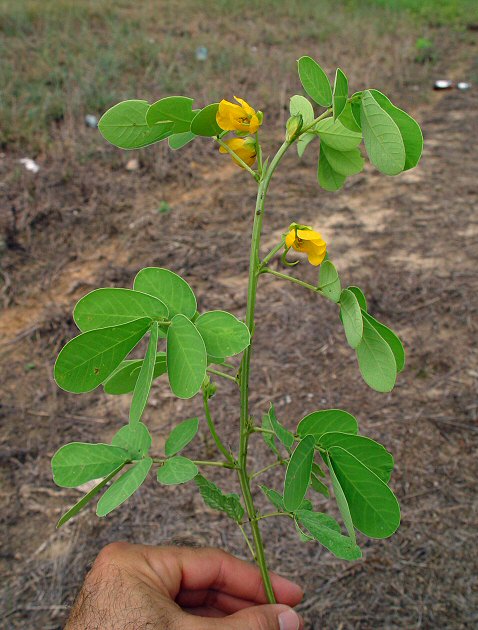Senna obtusifolia (L.) H.S. Irwin & Barneby
Sicklepod

Native
CC = 3
CW = 3
MOC = 9
© DETenaglia
Senna obtusifolia (L.) H.S. Irwin & BarnebySicklepod | |
 |
Native CC = 3 CW = 3 MOC = 9 |
© DETenaglia |
|
Family - Fabaceae/Caesalpinioideae Habit - Annual forb, sometimes perennial farther south, producing a disagreeable odor when bruised. Stems - Ascending to erect, to 1.0 m, single or multiple, usually unbranched, with scattered, minute glandular hairs and sometimes also sparse, short, appressed or incurved hairs toward the tip.
Leaves - Alternate, compound, petiolate. Petiole 2-4 cm long, the petiolar gland usually positioned between the lowermost leaflets, 1.5-2.0 mm long, narrowly columnar or slightly tapered from near the base, appearing sessile or more commonly short-stalked and angled toward the leaf tip. Leaf blades 5-8 cm long, with 2-3 pairs of opposite leaflets. Leaflets 2-6 cm long, 2-3 cm wide, broadly obovate to broadly obovate, oblique at the base, rounded or occasionally broadly angled to a very bluntly pointed tip, the margins with a pale, narrow band and short, ascending hairs, the surfaces glabrous or the undersurface with a few minute glandular or longer, nonglandular hairs toward the base.
Inflorescences - Axillary solitary or paired flowers, sometimes also appearing as small clusters at the stem tip, the flower stalks 10-25 mm long, becoming elongated to 40 mm at fruiting. Flowers - Calyces zygomorphic, the sepals variously 5-10 mm long, 2-3 mm wide, oblong-obovate to broadly elliptic, rounded to bluntly pointed at the tip, the margins with short, spreading hairs. Petals 7-14 mm long, 4-7 mm wide, oblong-obovate to obovate. Stamens with the anthers purplish brown. Ovary 4-6 mm long, with appressed or ascending hairs, the style 3-4 mm long.
Fruits - Legumes 9-16 cm long, 2-4 mm wide, arched downward at maturity, more or less circular to more commonly bluntly rectangular in cross-section, sparsely to moderately hairy when young, becoming glabrous at maturity, only slightly impressed between the seeds but with a pair of longitudinal ridges near the margins on each surface, greenish brown to brown at maturity. Seeds 3-5 mm long, 2.0-2.5 mm wide, somewhat rhomboidal to trapezoidal in outline, slightly flattened, the surface often developing a fine network of cracks toward the margins at maturity, reddish brown to dark brown, shiny, the pleurogram usually dull and slightly lighter than the rest of the seed.
Flowering - July - September. Habitat - Streambanks, sloughs, upland prairies, railroads, open disturbed areas. Origin - Probably native to (sub)tropical America. Lookalikes - Other species of Senna. Other info. - This species can be found in a handful of scattered Missouri counties, mostly in the far south of the state. Its main distribution within the continental U.S. is in the southeast, although its native range is not well understood. The plant is easy to identify from its big leaflets, big yellow flowers, and sickle-shaped (falcate) fruits. Photographs taken off Moores Mill Road, Auburn, AL., 8-18-04 and 8-26-04 (DETenaglia). |